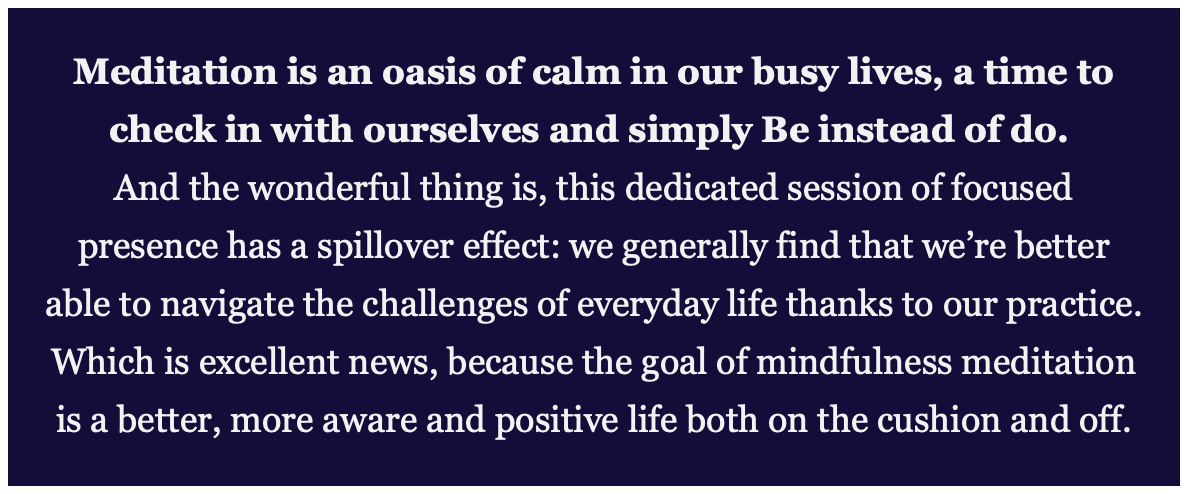Our jobs pay the bills, occupy many of our waking hours and can even give our lives meaning. But they can also be a source of significant stress: deadlines, long days and difficult conversations – no matter what your job, work can be anxiety-provoking. Mindfulness can help! In recent years, many companies have started teaching mindfulness in the office as it embraces using simple methods to reduce the impact workplace stress can have on your mind and body.


How can we bring meditation training
into the workplace?
Only a lucky few have breaks suitable for a formal session of practice built into their jobs. And if some companies have caught on to the great benefits of giving employees a dedicated space and enough time to unplug, most haven’t.
But there are many ways to meditate, and it is definitely possible to extend
your practice into your work life.
Here are five meditation tips for the busy meditator:
Meditating on the job…
1. Micro sessions
Depending on your work situation, you may be able to integrate quick meditation moments into your day. These can be programmed (every hour on the hour, three minutes, say) or random (take a mindful moment every time your colleague’s phone rings).
Mindfulness is a form of meditation that really works for this: putting your work brain on hold for just the time it takes to be aware of your breath. Mute your devices, take stock of what you’re feeling (whatever that may be), let it pass without following the storyline, and recenter on the breath. Even mini-sessions can leave you feeling refreshed and ready to continue your day with enthusiasm.

2. A grateful meal break
Whenever possible, search out a quiet corner of your building or head outdoors and enjoy your meal mindfully. While any basic meditation can be practiced while you’re eating and drinking, gratitude meditation is tailor-made for work breaks, including short ones.
This simple meditation is about being present and maintaining grateful awareness of all of the people, animals and other elements that contributed to making it possible for you to be right where you are, doing just what you’re doing. It’s a great way to create a buffer between the stresses and conflicts of the workplace and to appreciate the richness of the present moment.
3. Walking meditation
Whether walking to restock the shelves, heading from the teachers’ room to the classroom, or simply taking a break, instead of letting your thoughts wander where they will or paying attention to the environment, spend one conscious minute—more if you can—being fully aware of the physical sensation of walking, especially at the level of your feet and legs. This is easiest to do if you’ve integrated walking meditation into your formal practice outside of work.

4. Mantra
Mantras are phrases that are repeated to help you stay focused and positive. Originally, mantras mainly served a spiritual or religious purpose (both in the Eastern and the Judeo-Christian traditions). Nowadays they are also recognised as an effective and easy meditation technique for positive thinking, as in: “I am enough,”. Focusing on sounds creates both calm and one-pointedness.
5. Commuting
If you’re lucky enough to be able to walk to work, that’s a great time to unplug and take some walking meditation steps. If you have to drive or ride, the best way to meditate is still to unplug, and use the time to connect with whichever of the types of meditation is your go-to.
A Mindful Disposition
The goal of mindfulness isn’t to stop thinking, or to empty the mind. Rather, the point is to pay close attention to your physical sensations, thoughts and emotions in order to see them more clearly, without making so many assumptions, or making up stories.
It can be especially helpful to bring a mindful disposition to your job, which can be the source of significant stress. And workplace stress is becoming only more consuming, with email, intra-office chat tools and social media constantly competing for our attention, and often bleeding into downtime.
One way mindfulness can help is simply by allowing us to improve our focus. When we constantly flit from one task to another, the quality of our work can suffer. By practicing mindfulness; simply coming back to the present moment over and over again, we can train ourselves to become more focused. 
Reference: https://www.


Recent Comments